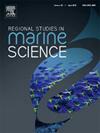Interannual variability in the distribution and biomass of five demersal fish species from shrimp bycatch and their relationship with environment in the Gulf of California
IF 2.1
4区 环境科学与生态学
Q3 ECOLOGY
引用次数: 0
Abstract
In the Gulf of California (GC), five fish species —Balistes polylepis, Paralabrax maculatofasciatus, Sphoeroides annulatus, Haemulopsis elongatus, and Diapterus brevirostris— are caught as bycatch in the industrial shrimp trawl fisheries. This study analyzed their distribution using the positive hauls from prospecting cruises, biomass through the swept area method, and environmental influences using multivariate methods from 2002 to 2018. The estimated absolute abundance was 52,181,219 individual organisms, with a total biomass of 4394.5 tons. The highest values were recorded in 2011, contributing more than 46 % of the total abundance and 54 % of the biomass, while the lowest values were observed in 2008 and 2018. H. elongatus (33 %) and D. brevirostris (25 %) were the most abundant species, whereas B. polylepis (41 %) and H. elongatus (22 %) dominated the biomass. According to our zoning of the GC, the North (N) zone contributed more than 50 % of the total abundance and biomass, followed by the Central (C) zone in the early years, with an increasing contribution from the South (S) and Southeast (SE) zones after 2015. Bathymetrically, the biomass in the SE and S zones was concentrated in the < 20 m stratum, while the > 40 m strata were relevant only in the N and S zones. H. elongatus and D. brevirostris exhibited a northward expansion, evidencing shifts in their geographic distribution. The PERMANOVA analysis indicated significant differences in biomass across years (F = 1.82, p = 0.00011) and zones (F = 1.95, p = 0.00141), but not across depth strata (p = 0.1971). Non-metric multidimensional scaling revealed temporal and spatial groupings, particularly for 2011, 2016, and 2005. Principal Component Analysis (PCA) explained 61.6 % of the variability, associating H. elongatus with the N zone and 2011, and D. brevirostris with the SE zone and 2016. Generalized Additive Models (GAMs) identified chlorophyll a (CHLA) and the Multivariate ENSO Index (MEI) as important environmental predictors of biomass variability in most species, explaining a significant portion of the deviance in their biomass patterns. These findings highlight the influence of environmental variability on biomass distribution, providing crucial insights for fisheries management in the GC region.
加利福尼亚湾副捕虾中五种底栖鱼类分布和生物量的年际变化及其与环境的关系
在加利福尼亚湾(GC),有五种鱼类是工业捕虾拖网渔业的副渔获物,它们分别是:长尾鳞虾、斑纹副虾、环状虾、长尾吸血虾和短尾蝶。本研究利用2002年至2018年勘探船的正拖拽量、通过扫面积法的生物量和使用多元方法的环境影响分析了它们的分布。估计绝对丰度为52181219个个体,总生物量为4394.5吨。2011年的丰度最高,占总丰度的46% %以上,占生物量的54% %以上,2008年和2018年的丰度最低。其中,长柄小蠹(33 %)和短柄小蠹(25 %)生物量最多,而长柄小蠹(41 %)和长柄小蠹(22 %)生物量最多。根据GC的分区,早期北(N)区对总丰度和生物量的贡献超过50% %,其次是中部(C)区,2015年后南(S)和东南(SE)区贡献增加。从深度上看,东南带和南带的生物量集中在<; 20 m地层,而>; 40 m地层只与N和S带有关。长形猿猴和短喙猿猴呈现向北扩张的趋势,表明其地理分布发生了变化。PERMANOVA分析表明,不同年份(F = 1.82, p = 0.00011)和不同区域(F = 1.95, p = 0.00141)的生物量差异显著,但不同深度(p = 0.1971)的生物量差异不显著。非度量多维尺度揭示了时空分组,特别是在2011年、2016年和2005年。主成分分析(PCA)解释了61.6 %的变异率,将长叶松与N区和2011年联系起来,将短叶松与SE区和2016年联系起来。广义加性模型(GAMs)发现叶绿素a (CHLA)和多元ENSO指数(MEI)是大多数物种生物量变异的重要环境预测因子,解释了其生物量模式偏差的重要部分。这些发现强调了环境变化对生物量分布的影响,为GC地区的渔业管理提供了重要的见解。
本文章由计算机程序翻译,如有差异,请以英文原文为准。
求助全文
约1分钟内获得全文
求助全文
来源期刊

Regional Studies in Marine Science
Agricultural and Biological Sciences-Ecology, Evolution, Behavior and Systematics
CiteScore
3.90
自引率
4.80%
发文量
336
审稿时长
69 days
期刊介绍:
REGIONAL STUDIES IN MARINE SCIENCE will publish scientifically sound papers on regional aspects of maritime and marine resources in estuaries, coastal zones, continental shelf, the seas and oceans.
 求助内容:
求助内容: 应助结果提醒方式:
应助结果提醒方式:


